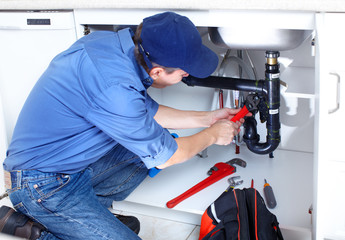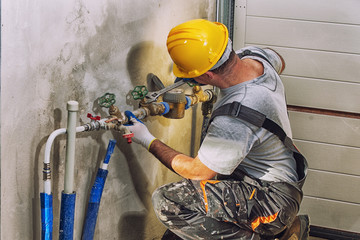Types of Plumbing Used by a Plumber
Plumber Westminster is responsible for the installation, maintenance, and repair of piping systems that distribute water, gas, and waste. They follow blueprints and building codes to create plumbing systems that are safe and efficient.
Many people consider becoming a plumber because it offers a good salary and steady job security. However, the career requires extensive on-the-job training.
Plumbing fixtures are essential for delivering water and removing waste, and they come in many different styles to suit personal preferences. Some of the most common types include sinks, faucets, showerheads, bathtubs, and toilets. Choosing the right fixtures can help create a custom home design that is both functional and stylish.
While there is no hard-and-fast rule dictating that all plumbing fixtures must match, matching them can contribute to a consistent aesthetic and create a more polished appearance. In addition, coordinating fixtures can also elevate other aspects of the design, such as cabinetry, countertops, and hardware.
Before selecting plumbing fixtures, it is important to consider the function and quality that are most important. The best fixtures will align with specific usage requirements, providing ease of use and reliable performance. Additionally, the fixtures should fit seamlessly into the overall design scheme to ensure a cohesive appearance.
Another consideration is the environmental impact of each fixture. Using low-flow plumbing fixtures can reduce energy and water consumption, which is beneficial for the environment. Additionally, by reducing their overall waste production, homeowners can support larger sustainability initiatives.
While plumbing fixtures may seem like a minor part of the home’s infrastructure, they can have a significant impact on the surrounding environment. To minimize their environmental footprint, homeowners can choose green products, recycle old fixtures when they remodel, and schedule regular maintenance inspections. Additionally, they can install gray-water reuse systems to cut down on water usage, and they can contact a plumber for plumbing repairs to reduce water loss. This will help conserve natural resources and reduce the stress on local ecosystems.
Pipes and Fittings
Pipe fittings connect or join lengths of pipes, making it possible for a plumbing system to change direction, control the flow of water and steam, increase or decrease size or extend a network. They also protect pipes from damage and prevent water loss due to leaks or corrosion. Plumbers use a variety of different types of pipe and tubing fittings.
Pipe-fitting materials vary, but most are constructed from non-corrosive metals that can withstand water pressure and temperature extremes. Plumbers use a variety of fasteners, such as hex nuts and backnuts, to connect these fixtures to other components in the plumbing system. They also work with different types of pipes and piping systems, including copper, black steel, galvanized steel, PEX, chlorinated polyvinyl chloride (CPVC) and ABS plastic.
Threaded pipe fittings require a special wrench to screw together, but they provide a stronger, more durable connection than welded joints. They are also suitable for systems that might need to be taken apart frequently for maintenance and repairs. Solvent welding uses a solvent to partially dissolve and fuse the adjacent surfaces of a pipe and a fitting, but it is not recommended for DWV systems or potable water lines.
Other types of pipe fittings include elbows, couplings, adapters and tees. Elbows are available in various angles and sweeps, such as long- or short-radius styles. These allow you to take a pipe in or out of a wall or corner with ease and reduce the amount of water pressure lost. A coupling is a sleeve that connects two pipes at their ends, and it may have a small ridge or stop internally to prevent the over-insertion or under-insertion of the second pipe segment. A reducing coupling is similar to a coupling but has a reduced diameter sleeve.
Drains and Vents
Vents are essential to the smooth flow of water through pipes. They prevent vacuums from forming that can hinder or even halt drainage, and they help ensure proper pressure balance throughout the system. They also allow sewer gases to escape, preventing these unpleasant odors from seeping into living spaces. Plumbing vents are often overlooked, but they play a vital role in the health and safety of your home or business.
A well-functioning plumbing vent will have a clear path to the outside, which is necessary for regulating pressure and expulsion of gases. If the vents are blocked by debris, the system will have difficulty maintaining proper airflow and balancing pressure, which can lead to drain problems like slow-draining sinks or gurgling sounds. Regularly clearing external vent openings can help avoid blockages, but serious issues may require professional attention.
In addition to allowing waste water to leave fixtures, plumbing vents help to keep the traps in P-traps, the U-shaped bends beneath sinks and tubs, water-filled and creating a seal that blocks dangerous sewer gasses from entering living spaces. Without adequate ventilation, the water in these traps can suck up air instead of waste, breaking this important barrier and releasing foul odors into living spaces. Plumbing vents ensure that these traps remain water-filled by keeping air in the plumbing system.
These vents are typically located outdoors, which makes them vulnerable to weather changes and other environmental factors. They can be clogged by rodents and birds looking for nesting places, as well as by snow and other debris. They also require regular cleaning to maintain their integrity. A plumber can clean or replace clogged vents to restore proper airflow and remove foul smells.
Water Pressure
Water pressure is how hard the water tries to move through your pipes. It’s usually measured in pounds per square inch (psi). The higher the pressure, the harder it is to move the water. Your home’s piping system can have problems that affect both water flow and water pressure.
For example, if you have a clogged showerhead or aerator, it can restrict the flow of water. A simple clean-out can help. You might also have low water pressure because of a hidden leak in your plumbing system. A plumber can find the leak and fix it.
If you have low water pressure in your whole house, it could be a problem with the main water line from the city or town. The pressure may be lower at certain times of the day or year, depending on demand and other factors. Your home’s elevation can affect your water pressure, as can the size of your main water pipe and the number of homes it supplies.
Low water pressure can be caused by mineral build-up in your pipes, a broken pressure regulator or other issues inside and outside your home. If you’re having trouble with both water flow and pressure, a video drain inspection from your local plumber can help you determine the cause.
If you’re having a problem with your water pressure, first check to make sure your water meter valve isn’t closed. It’s possible that a technician working on your plumbing system closed this valve mistakenly. If this is the case, the problem can be resolved by having your plumber re-open this valve. Also, check to see if your water service line is closed, which can happen during construction or utility work in your area.
Leaks
A household leak is not only inconvenient, it can cause water damage to your home’s structure and contents. Over time, a slow leak can lead to mold growth, rotting wood, sagging floors and ceilings, warped furniture, and peeling paint. Leaks can also lead to increased water bills and a decrease in your home’s water pressure.
Leaks can occur anywhere in your home’s plumbing system, and can be caused by a variety of issues. The most common cause of household leaks is worn-out seals, valves and washers. This can be caused by heavy use or a lack of maintenance. Another common source of leaks is damaged or old pipes, which can develop cracks or holes over time.
Other causes of leaks can include earthquakes, which can damage water and sewer lines above and below ground; and tree roots, which can wrap around and pierce pipes. Leaks can be repaired using a variety of methods, including epoxy coating, pipe bursting, and replacement pipes. The best method for your home will depend on the severity of the leak, your budget, and your home’s plumbing system. If you have a leak, it’s important to call a plumber right away. The longer you wait, the worse the problem will become.


